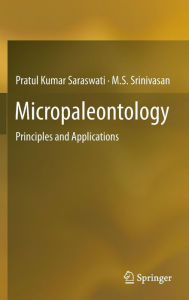Micropaleontology: Principles and Applications. Pratul Kumar Saraswati, M.S. Srinivasan

Micropaleontology.pdf
ISBN: 9783319145730 | 190 pages | 5 Mb

- Micropaleontology: Principles and Applications
- Pratul Kumar Saraswati, M.S. Srinivasan
- Page: 190
- Format: pdf, ePub, fb2, mobi
- ISBN: 9783319145730
- Publisher: Springer International Publishing
Download spanish audio books for free Micropaleontology: Principles and Applications by Pratul Kumar Saraswati, M.S. Srinivasan English version 9783319145730 FB2 PDF
This book will help readers learn the basic skills needed to study microfossils especially those without a formal background in paleontology. It details key principles, explains how to identify different groups of microfossils, and provides insight into their potential applications in solving geologic problems. Basic principles are addressed with examples that explore the strengths and limitations of microfossils and their geological records. This overview provides an understanding of taphonomy and quality of the fossil records, biomineralization and biogeochemistry, taxonomy, concepts of species, and basic concepts of ecology. Readers learn about the major groups of microfossils, including their morphology, ecology, and geologic history. Coverage includes: foraminifera, ostracoda, coccolithophores, pteropods, radiolaria, diatoms, silicoflagellates, conodonts, dinoflagellates, acritarch, and spores and pollens. In this coverage, marine microfossils, and particularly foraminifera, are discussed in more detail compared with the other groups as they continue to play a major role in most scientific investigations. Among the various tracers of earth history, microfossils provide the most diverse kinds of information to earth scientists. This richly illustrated volume will help students and professionals understand microfossils and how to work with them for evolution of life, age and paleoenvironment of sedimentary strata, paleoclimate, and paleoceanography.
Bordeaux Training Session - Changing Arctic and Subarctic
Late Quaternary paleoceanography - Marine micropaleontology - XRF core canner T3: Principles and application of XRF core canner measurements and XR
Graduate programs - University of California Museum of Paleontology
Graduate degrees with emphasis in paleontology may be earned in the Departments of the General Catalog of UC Berkeley, or visiting the department's website (see Application process below). Principles of Phylogenetics: Systematics
Dinocyst - Wikipedia, the free encyclopedia
Marine Micropaleontology http://dx.doi.org/10.1016/j.marmicro.2012.08.002; Jump up In: Palynology: principles and applications (Ed. by J. Jansonius & D. C.
Micropaleontology and chemostratigraphy - Czech Geological Survey
Publishing services · List of web applications Micropaleontology and chemostratigraphy Basic principle of the method 501 is palynological maceration: it is a set of different very specialized methods for an isolation of acido- resistant
Jobs & Internships: Current Students: MS in Geology: UNCW
Application of principles to economic deposits. Laboratory GLY 531. Micropaleontology (3) Prerequisite: Invertebrate paleontology or consent of instructor.
Pierre Zippi - Dedman College - SMU
Paleontology and Paleoenvironmental Interpretation of the Kikak-Tegoseak Quarry (Prince Palynology: principles and applications; American Association of
Document 1 - Plymouth
MSc Marine Micropalaeontology. MRes Marine The Marine Micropalaeontology pathway leader is following: principles and applications of electron
Department of Palaeontology - Benjamin Sames
Applied Micropalaeontology: Ostracoda (Crustacea) Fundamentals, principles and methods of the biostratigraphic application of (late) Mesozoic non-marine
Download more ebooks:
Download PDF Splicing Modern Ropes: A Practical Handbook
[Descargar pdf] TUS DOS PIRÁMIDES
{epub descargar} NO CERRAMOS EN AGOSTO
0コメント